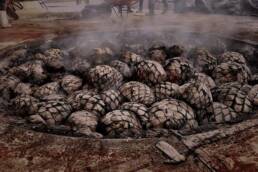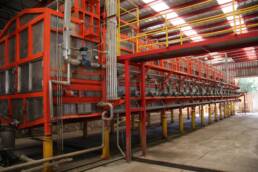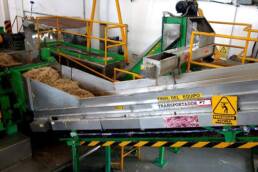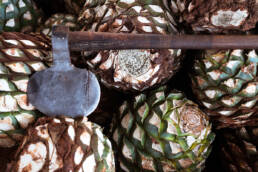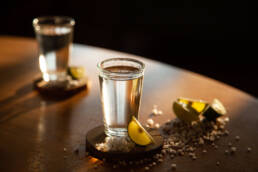Tequila; a distilled spirit that has been around for hundreds of years and inhabited the shot glasses and margaritas of billions, but there is a history and a process behind the many (un)forgettable nights sipping with sides of salt and lime, and conversations being brought to the surface on the production of Tequila. Specifically, diffuser tequila vs non diffuser tequila and why the need for this method of production was brought about.
Tequila is made from the Weber blue agave plant or agave tequilana, which is a large succulent similar to Aloe Vera with large spiked leaves. In the core of this plant is a bulb called a Piña, this is then baked and juiced and the juice is fermented in tanks with yeast then distilled to make tequila (in a nutshell).
There are three different methods to cook the agave each with separate goals in mind. There is the most traditional stone/brick oven, this method is known to be old school however it does produce a high quality tequila. For this the agave is cooked for around 36 hours and then requires another day or so to cool down afterwards, while this is very traditional it is expensive, and in the modern age of tequila and fast consumers, time is money. The next method is called the Autoclave; these are giant steel tubes that can cook agave in around 8 hours under intense steel pressure and better yet, they can cook more agave at a time. However even with these two methods on hand there was a need for something even faster and more efficient, this is where the diffuser comes in.
For anyone who has tasted the difference between diffuser and non-diffuser made tequila or taken the plunge into the tequila blind taste testing YouTube community, you may notice a pattern in the results. Often noting that diffuser made tequila can have a slight chemical flavour, however some have noted it to have a clean and citric flavour profile, but many say that the beauty of the agave tends to be overshadowed. This of course raises the question, if the contraption has brought about controversy and according to some consumers doesn’t replicate the flavour of a good quality tequila, then how did the need for the Diffuser come about?
While the traditional method of producing tequila in say a stone oven or an autoclave produced a good quality tequila that could be marketed as 100% agave, this created a problem as the demand from consumers skyrocketed. People were passing up on tequilas with added grain alcohol or the more efficient, poorly made ‘mixtos’ because they wanted the cien por ciento (pure agave), however the issue that tequila producers found themselves up against is this demand was using up all of their agave. They couldn’t go back to blending in grain alcohol as that would destroy the integrity of the market they had just worked to create, hence the diffuser was born.
Now if you’re unsure, a diffuser is a machine (the size of a basketball court for scale) that inverses the traditional tequila-making process, it is the fastest and cheapest way to make Tequila. Instead of first cooking and separating the sugars from the fibres, a diffuser extracts the starches and then uses high pressure blasts of water as agave passes on a conveyer belt. As this process happens when the agave is uncooked it can be known to strip away that flavour profile, which is rectified later on through the use of additives. The major benefit that comes from using a diffuser is the speed of production, it aids brands in catering for their rapidly growing customer base. Blue Agave takes 6-8 years to fully ripen, and with the sales of tequila at an all time high this is too long for some producers to wait to meet the needs of their consumers.
Traditionally in the production of tequila, the piñas are cooked, crushed and pressed to extract the sugars which are then fermented in tanks or vats similar to those in winemaking. For this reason the produce is required to be ripe as the sugar is needed for a healthy fermentation. The sugars that are present within a ripe agave plant produce the flavour profile in tequila that has been loved for generations and led to the rise of Tequila aficionados globally. A diffuser eliminates the cooking process completely and as an extension, the ripening process, so one crop wouldn’t need the 6-8 year waiting period which in turn is able to speed up the entire process. As the diffuser uses uncooked, and in many cases young agave plants the extraction process involves spraying the plant with hot water to extract the starches which are then collected in a tank, where they are boiled with an added enzyme to convert the starches into sugar. Whilst this method consequently results in a completely different flavour profile, it still allows brands to label their products as 100% Agave Tequila.
Basically, as the demand for tequila began to grow, waiting 6-8 years years for an agave crop to ripen and then pouring in lots of money to harvest and manufacture it created a supply and demand issue which the diffuser has eliminated.
Tequila has its roots in tradition when it comes to production methods, and it’s essence is the agave. Both diffuser and non diffuser tequila distill agave but in different ways. Of course there will always be debates raised when tradition is altered, even if in this case the alteration comes from a place of innovation and the desire to increase mass production. But with new solutions there will always be new problems and the change of a beloved flavour profile will raise discussions. Mexico’s exports of tequila from 1995 to 2020 have grown substantially each year. In the beginning of the century, exports of the distilled spirit was less than 100 million litres and by 2020 the figure was nearly two and a half times higher reaching close to 287 million litres, and accounting for nearly 77% of the countries tequila production that year. So with these numbers climbing dramatically year by year with the help of the diffuser begs the most important question, will there be enough agave to keep this momentum going?



